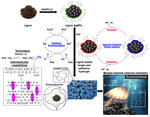
Abstract:
The engineering of multifunctional biomaterials using a facile sustainable methodology that follows the principles of green chemistry is still largely unexplored but would be very beneficial to the world. Here, the employment of catalytic reactions in combination with biomass-derived starting materials in the design of biomaterials would promote the development of eco-friendly technologies and sustainable materials. Herein, we disclose the combination of two catalytic cycles (combined catalysis) comprising oxidative decarboxylation and quinone-catechol redox catalysis for engineering lignin-based multifunctional antimicrobial hydrogels. The bioinspired design mimics the catechol chemistry employed by marine mussels in nature. The resultant multifunctional sustainable hydrogels (1) are robust and elastic, (2) have strong antimicrobial activity, (3) are adhesive to skin tissue and various other surfaces, and (4) are able to self-mend. A systematic characterization was carried out to fully elucidate and understand the facile and efficient catalytic strategy and the subsequent multifunctional materials. Electron paramagnetic resonance analysis confirmed the long-lasting quinone-catechol redox environment within the hydrogel system. Initial in vitrobiocompatibility studies demonstrated the low toxicity of the hydrogels. This proof-of-concept strategy could be developed into an important technological platform for the eco-friendly, bioinspired design of other multifunctional hydrogels and their use in various biomedical and flexible electronic applications.







